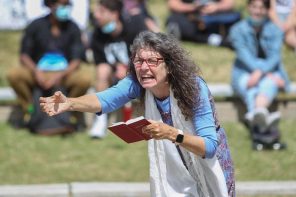35 years ago, on November 19, 1978, 73-year-old Hyacinth Thrash awoke to a nightmare in the jungles of Guyana. In one of the largest murder-suicides in world history, 918 people from her Peoples Temple church lay dead before her eyes, poisoned by a lethal cocktail of cyanide and fruit punch. The images from this gothic scene of carnage have become indelible: bodies, clad in simple workaday clothing, stretch into the distance in rows, face down on the ground. Seldom discussed and less widely known, however, is the fact that they are overwhelmingly black bodies.
Rendered “anonymous,” they represent complex extended families of children, elderly women, young women, mothers, grandmothers, aunts, sisters and nieces. They came to Jonestown, Guyana from communities all across the U.S., drawn by the utopic promise of life in a communal settlement, envisioned by a charismatic white messiah, as a socialist refuge from American racial apartheid. One of the most haunting scenes from the massacre’s aftermath is that of an adult with their arm around a child, protective in the throes of death. Thrash was the sole survivor on the premises.
Although the gruesome final snapshot of Jonestown is burned into the American popular imagination, the prelude to the massacre is not as well known. Founded by the Reverend Jim Jones in the 1950s, Peoples Temple was a multiracial Pentecostal congregation with roots in Indiana. Over the course of two decades the church would establish operations in Ukiah, San Francisco and Los Angeles before relocating the bulk of the congregation to Guyana in the late ‘70s, ostensibly to avoid government persecution for its radical views.
About 75% of Peoples Temple members were African American, 20% were white and 5% were Asian, Latino and Native American. The majority of its black members were women, while its core leadership was predominantly white. As per the cultural cliché, black women like Thrash were “the backbone” of Peoples Temple, the primary victims of Jonestown, and the population with the deepest investment in the philosophy, ethos and mission of the church.
It is troubling that of the scores of book length personal accounts, critical analyses and sociological appraisals on Peoples Temple and Jonestown only a few are by black women (the best of these have been compiled at the “Alternative Considerations of Jonestown and Peoples Temple” site). Thrash and Leslie Wagner–Wilson are currently the only two black women survivors to publish books on their experiences. Wagner-Wilson managed to escape Jonestown before the massacre with several of her family members.
As early African American members of the church when it was based in Indiana, Thrash and her sister tithed 20% of their income to Peoples Temple. Thousands of dollars in property sales, Social Security, disability, and welfare benefits from Temple members were funneled into the church’s empire. Despite being elderly and infirm, Thrash and her sister followed Jones from Indiana to Ukiah, San Francisco and Guyana before Thrash became disgruntled with the divide between Jones’ rhetoric of racial equality and the white-people-first reality of church leadership, though she nonetheless chose to remain.
Unpacking why so many black women died in Jonestown requires taking a critical look back at the racial underbelly of the Jonestown age. It demands confronting hard truths about the dangerously gendered seductions of organized religion; particularly given the global appeal that 24/7 prayer movements and charismatic Pentecostalism have for women of color.
According to a 2012 Kaiser Foundation/Washington Post poll, black women are among the most steadfastly religious groups in the nation. Only 2% said that being religious was not important to them at all (compared to 15% of white men), while 74% said that it was extremely important. Numerous surveys have touted the decline of American religiosity within the past decade and yet, in an era of black economic depression, the need to be devout or churched-up has not diminished for most African-American women, despite the often patriarchal, heterosexist orientation of the Black Church.
The widening wealth gap between blacks, whites and Latinos, coupled with the downward mobility of the black middle class, only amplifies the role of religion in black life. Because charismatic faith movements thrive in the presence of socioeconomic and political turbulence black religiosity is flourishing (as the breakout popularity of the new reality show Preachers of L.A. attests).
Peoples Temple rose to prominence in San Francisco during the turbulence of the post-civil rights, post-Black Power, post-Vietnam War era. A self-proclaimed Marxist who fetishized black liberation struggle, Jim Jones actively courted the support and approval of the Bay Area liberal political establishment. He skillfully mined the language of social justice, racial equality and anti-sexism in an era in which disillusion with the possibility of freedom from institutional oppression ran high.
He touted a liberation theology ethos (what he called ‘apostolic socialism’) which married the “best” parts of the Christian social gospel with a vision of communalism and egalitarianism that more closely aligned with his inherent atheism. Initially this rhetoric was actualized in an array of social welfare programs (such as free community meals, housing and health care) for church members, though it would ultimately be perverted through a systematic pattern of paranoia, abuse and persecution fueled by Jones and his inner circle.
Numerous accounts document how Temple members were party to and complicit in the public abuse, harassment, humiliation and sexual exploitation of fellow parishioners. Some members vigorously defended these practices up until the final act of murder-suicide, an event that had been promoted and rehearsed several times. When the fated day came, Christine Miller, an African-American woman in her 50s, was the sole objector caught on the so-called death tape, challenging Jones’ death decree until she was shouted down by zealous African-American Temple members.
It’s difficult to listen to or read these accounts without feeling the deep complicity of the community. As many survivors have stated, Peoples Temple was initially an uplifting experience because of its ability to unify members around the common cause of social justice. Its message of racial harmony and cultural diversity resonated with white counterculture folk, aging white radicals, and progressive Christians looking for an alternative to the insularity of mainstream traditions like the Black Church and people of color from all walks of life.
But this veneer of equality hid a pernicious race and gender hierarchy in which the Temple’s vaunted inner circle was comprised of white women who were fatally loyal to Jones and his perverse will. This tight knit cadre of white women was Jones’ brain trust, acting as his psychological henchwomen and enforcers, handling Temple funds, intimidating potential defectors, and seducing VIPs out of political expediency.
To paraphrase San Diego State University professor Rebecca Moore—whose sisters Carolyn Layton and Annie Moore were two of Jones’ main lover/lieutenants—if any Peoples Temple constituency had the power to stop the Jonestown massacre, these women did. But in eschewing the bourgeois trappings of “proper” white femininity they wound up reinforcing a white supremacist social order that some African-American members likened to that of the plantation, complete with Miss Ann wielding the whip.
In many regards, Jones became the charismatic white Jesus father-figure that so many black women are besotted with today. In The Onliest One Alive, Thrash speaks of how Jones’ straying from the Bible was the fatal flaw of Peoples Temple; if he’d only been more of a God-fearing Christian, instead of a false prophet who set himself up as God, then surely the massacre wouldn’t have happened.
She believed she was spared from the massacre because “guardian angels” were protecting her and “God was in the plan.” But where was God for the 918 dead, some of the devoutest women on the planet?





